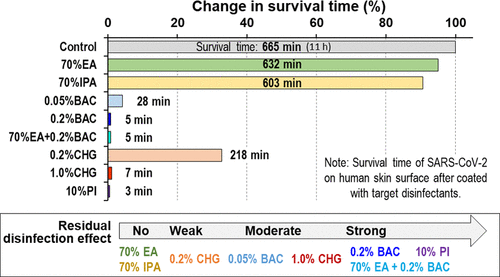
COVID-19: Disinfectant’s anti-virus residual disinfection effect: Kyoto Prefectural University of Medicine
-“How to significantly reduce virus survival time on human skin”-
reaserch result:
After applying the disinfectant to your hands and letting it dry,
How effective is it in disinfecting?
We built a model that can be evaluated accurately.
Ethanol, isopropanol, etc .:
Alcohol-based disinfectants had almost no residual disinfectant effect.
On the other hand, for disinfectants such as chlorhexidine gluconate and benzalkonium chloride,
Residual disinfection effect was recognized.
Compare residual disinfection effect:
“A relatively high concentration of 0.2% benzalkonium chloride” showed a particularly strong residual disinfecting effect.
New coronavirus,
Human coronavirus,
Influenza virus,
Each survival time
665 to 5 minutes (less than 1%),
1285 to 12 minutes (less than 1%),
It was shortened from 121 minutes to 4 minutes (3%).
This strong residual disinfectant effect was maintained for 4 hours after application to the skin.
Strong support for hand hygiene:
Apply a disinfectant with a strong residual disinfectant effect to the skin.
“This creates a skin surface where the virus is less likely to survive.”
Strongly supports current hand hygiene.
It is expected to be an innovative contact infection prevention method.
https://www.kpu-m.ac.jp/doc/news/2021/20211127.html
4 hours of effect “miracle disinfectant” discovered by the Japanese research team | JoongAng Ilbo
https://s.japanese.joins.com/JArticle/285291?sectcode=400&servcode=400
Evaluation of the Residual Disinfection Effects of Commonly Used Skin Disinfectants against Viruses:
An Innovative Contact Transmission Control Method
Abstract
Lasting disinfection effects, that is, the residual disinfection effects (RDEs), of skin-coated disinfectants
have rarely been considered for infection control owing to the challenges involved in the accurate evaluation of RDEs.
In this study,
we constructed a new skin evaluation model and determined the RDEs of existing disinfectants against viruses.Our results showed that
ethanol and isopropanol had no RDE, whereas povidone–iodine, chlorhexidine gluconate, and benzalkonium chloride (BAC) exhibited RDEs,with 10% povidone–iodine and 0.2% BAC showing particularly strong RDEs.
The RDE of 0.2% BAC was strong enough to reduce
the median survival times of severe acute respiratory syndrome
coronavirus-2,
human coronavirus-OC43,
and influenza virus
from 670 to 5.2,
1300 to 12,
and 120 to 4.2 min, respectively.Additionally,
this strong RDE was maintained even 4 h after coating the skin.Clinical data also showed that the strong RDE of 0.2% BAC was maintained for more than 2 h.
Thus,
applying disinfectants with strong RDEs on the skin correlates with a reduction in virus survival timeand appears to create a skin surface environment that is not conducive to virus survival.
A prolonged reduction in virus survival decreases the contact transmission risk, thereby enabling stronger infection control.
Environmental Science & Technology